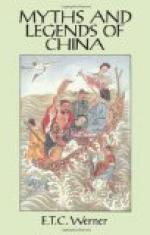He is sometimes represented holding his feather-fan, Yue-mao Shan; at other times the peach of immortality. Since his admission to the ranks of the gods, he has appeared on earth at various times as the messenger of Heaven. On one of these occasions he met Lue Yen, as narrated on p. 297.
Lan Ts’ai-ho
Lan Ts’ai-ho is variously stated to have been a woman and an hermaphrodite. She is the strolling singer or mountebank of the Immortals. Usually she plays a flute or a pair of cymbals. Her origin is unknown, but her personal name is said to have been Yang Su, and her career is assigned to the period of the T’ang dynasty. She wandered abroad clad in a tattered blue gown held by a black wooden belt three inches wide, with one foot shoeless and the other shod, wearing in summer an undergarment of wadded material, and in winter sleeping on the snow, her breath rising in a brilliant cloud like the steam from a boiling cauldron. In this guise she earned her livelihood by singing in the streets, keeping time with a wand three feet long. Though taken for a lunatic, the doggerel verse she sang disproved the popular slanders. It denounced this fleeting life and its delusive pleasures. When given money, she either strung it on a cord and waved it to the time of her song or scattered it on the ground for the poor to pick up.
One day she was found to have become intoxicated in an inn at Feng-yang Fu in Anhui, and while in that state disappeared on a cloud, having thrown down to earth her shoe, robe, belt, and castanets.
According to popular belief, however, only one of the Eight Immortals, namely, Ho Hsien-ku, was a woman, Lan Ts’ai-ho being represented as a young person of about sixteen, bearing a basket of fruit. According to the Hsiu hsiang Pa Hsien tung yu chi, he was ’the Red-footed Great Genius,’ Ch’ih-chiao Ta-hsien incarnate. Though he was a man, adds the writer, he could not understand how to be a man (which is perhaps the reason why he has been supposed to be a woman).
Chang Kuo
The period assigned to Chang Kuo is the middle or close of the seventh to the middle of the eighth century A.D. He lived as a hermit on Chung-t’iao Shan, in the prefecture of P’ing-yang Fu in Shansi. The Emperors T’ai Tsung and Kao Tsung of the T’ang dynasty frequently invited him to Court, but he persistently refused to go. At last, pressed once more by the Empress Wu (A.D. 684-705), he consented to leave his retreat, but was struck down by death at the gate of the Temple of the Jealous Woman. His body began to decay and to be eaten by worms, when lo! he was seen again, alive and well, on the mountains of Heng Chou in P’ing-yang Fu. He rode on a white mule, which carried him thousands of miles in a day, and which, when the journey was finished, he folded up like a sheet of paper and put away in his wallet. When he again required its services, he had only to spurt water upon the packet from his mouth and the animal at once assumed its proper shape. At all times he performed wonderful feats of necromancy, and declared that he had been Grand Minister to the Emperor Yao (2357-2255 B.C.) during a previous existence.




